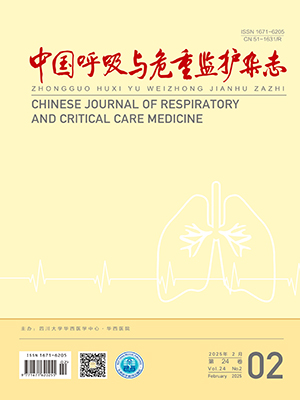| 1. |
Barker AF, Bergeron A, Rom WN, et al. Obliterative bronchiolitis. N Engl J Med, 2014, 370(19): 1820-1828.
|
| 2. |
Chien JW, Duncan S, Williams KM, et al. Bronchiolitis obliterans syndrome after allogeneic hematopoietic stem cell transplantation-an increasingly recognized manifestation of chronic graft-versus-host disease. Biol Blood Marrow Transplant, 2010, 16(1 Suppl): S106-S114.
|
| 3. |
Khateri S, Ghanei M, Keshavarz S, et al. Incidence of lung, eye, and skin lesions as late complications in 34, 000 Iranians with wartime exposure to mustard agent. J Occup Environ Med, 2003, 45(11): 1136-1143.
|
| 4. |
Ghanei M, Mokhtari M, Mohammad MM, et al. Bronchiolitis obliterans following exposure to sulfur mustard: chest high resolution computed tomography. Eur J Radiol, 2004, 52(2): 164-169.
|
| 5. |
Ghanei M, Tazelaar HD, Chilosi M, et al. An international collaborative pathologic study of surgical lung biopsies from mustard gas-exposed patients. Respir Med, 2008, 102(6): 825-830.
|
| 6. |
Parmet AJ. Bronchiolitis in popcorn-factory workers. N Engl J Med, 2002, 347(24): 1980-1982.
|
| 7. |
Parmet AJ, Von Essen S. Rapidly progressive, fixed airway obstructive disease in popcorn workers: a new occupational pulmonary illness?. J Occup Environ Med, 2002, 44(3): 216-218.
|
| 8. |
Kreiss K, Gomaa A, Kullman G, et al. Clinical bronchiolitis obliterans in workers at a microwave-popcorn plant. N Engl J Med, 2002, 347(5): 330-338.
|
| 9. |
Chang AB, Masel JP, Masters B. Post-infectious bronchiolitis obliterans: clinical, radiological and pulmonary function sequelae. Pediatr Radiol, 1998, 28(1): 23-29.
|
| 10. |
Kim CK, Kim SW, Kim JS, et al. Bronchiolitis obliterans in the 1990s in Korea and the United States. Chest, 2001, 120(4): 1101-1106.
|
| 11. |
Perez T, Remy-Jardin M, Cortet B. Airways involvement in rheumatoid arthritis: clinical, functional, and HRCT findings. Am J Respir Crit Care Med, 1998, 157(5 Pt 1): 1658-1665.
|
| 12. |
甄俊锋, 张路, 曹欣欣, 等. 合并副肿瘤天疱疮及闭塞性细支气管炎的单中心型 Castleman 病临床分析. 中国医学科学院学报, 2017, 39(4): 492-498.
|
| 13. |
Jindal T, Meena M, Kumar A, et al. Paraneoplastic pemphigus with Castleman's disease and bronchiolitis obliterans. Pediatr Int, 2011, 53(6): 1108-1109.
|
| 14. |
Morikawa K, Tsuji T, Yamasaki H, et al. Paraneoplastic pemphigus occurs most commonly in indolent B cell lymphoma. Acta Haematol, 2014, 132(1): 73-74.
|
| 15. |
Lee J, Bloom R, Amber KT. A systematic review of patients with mucocutaneous and respiratory complications in paraneoplastic autoimmune multiorgan syndrome: Castleman's disease is the predominant malignancy. Lung, 2015, 193(4): 593-596.
|
| 16. |
Aguilar PR, Michelson AP, Isakow W. Obliterative bronchiolitis. Transplantation, 2016, 100(2): 272-283.
|
| 17. |
Christie JD, Edwards LB, Kucheryavaya AY, et al. The Registry of the International Society for Heart and Lung Transplantation: 29th adult lung and heart-lung transplant report-2012. J Heart Lung Transplant, 2012, 31(10): 1073-1086.
|
| 18. |
Au BK, Au MA, Chien JW. Bronchiolitis obliterans syndrome epidemiology after allogeneic hematopoietic cell transplantation. Biol Blood Marrow Transplant, 2011, 17(7): 1072-1078.
|
| 19. |
Yen KT, Lee AS, Krowka MJ, et al. Pulmonary complications in bone marrow transplantation: a practical approach to diagnosis and treatment. Clin Chest Med, 2004, 25(1): 189-201.
|
| 20. |
Shi JH, Liu HR, Xu WB, et al. Pulmonary manifestations of Sjogren's syndrome. Respiration, 2009, 78(4): 377-386.
|
| 21. |
Reynaers A, Degreef H. Severe erosive stomatitis: association with immunological diseases?. Dermatology (Basel, Switzerland), 1997, 194(4): 411-415.
|
| 22. |
Zhu X, Zhang B. Paraneoplastic pemphigus. J Dermatol, 2007, 34(8): 503-511.
|
| 23. |
Devakonda A, Raoof S, Sung A, et al. Bronchiolar disorders: a clinical-radiological diagnostic algorithm. Chest, 2010, 137(4): 938-951.
|
| 24. |
Hansell DM, Lynch DA, McAdams HP, et al. Imaging of Diseases of the Chest. 5th edition. Mosby, 2009: 189-191.
|
| 25. |
Lynch JP 3rd, Weigt SS, DerHovanessian A, et al. Obliterative (constrictive) bronchiolitis. Semin Respir Crit Care Med, 2012, 33(5): 509-532.
|
| 26. |
Estenne M, Maurer JR, Boehler A, et al. Bronchiolitis obliterans syndrome 2001: an update of the diagnostic criteria. J Heart Lung Transplant, 2002, 21(3): 297-310.
|
| 27. |
Flowers ME, Martin PJ. How we treat chronic graft-versus-host disease. 2015, 125(4): 606-615.
|
| 28. |
Bergeron A, Belle A, Chevret S, et al. Combined inhaled steroids and bronchodilatators in obstructive airway disease after allogeneic stem cell transplantation. Bone Marrow Transplant, 2007, 39(9): 547-553.
|
| 29. |
Bergeron A, Chevret S, Chagnon K, et al. Budesonide/Formoterol for bronchiolitis obliterans after hematopoietic stem cell transplantation. Am J Respir Crit Care Med, 2015, 191(11): 1242-1249.
|
| 30. |
Williams KM, Cheng GS, Pusic I, et al. Fluticasone, azithromycin, and montelukast treatment for new-onset bronchiolitis obliterans syndrome after hematopoietic cell transplantation. Biol Blood Marrow Transplant, 2016, 22(4): 710-716.
|
| 31. |
Williams KM. How I treat bronchiolitis obliterans syndrome after hematopoietic stem cell transplantation. Blood, 2017, 129(4): 448-455.
|
| 32. |
Norman BC, Jacobsohn DA, Williams KM, et al. Fluticasone, azithromycin and montelukast therapy in reducing corticosteroid exposure in bronchiolitis obliterans syndrome after allogeneic hematopoietic SCT: a case series of eight patients. Bone Marrow Transplant, 2011, 46(10): 1369-1373.
|




